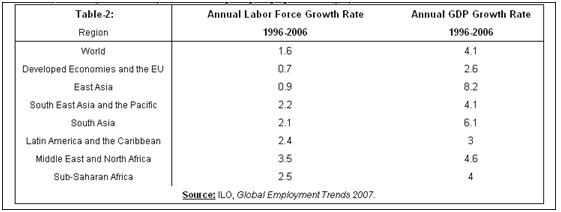Difference between revisions of "Labor Market Influence (supplier)"
(New page: ==Description== Labor markets function through the interaction of workers and employers. Traditionally, labor markets have been thought to be perfectly competitive. That is, there are many...) |
|||
| Line 3: | Line 3: | ||
<br> | <br> | ||
As the supply of human resource, development of labor market is much relevant to development the future office. Align with the growth of population, higher education, professional skill and working experience are required to meet the need of job competition and capable with position of job. | As the supply of human resource, development of labor market is much relevant to development the future office. Align with the growth of population, higher education, professional skill and working experience are required to meet the need of job competition and capable with position of job.<br> | ||
[[image:labor market1.jpg]] | |||
==Enablers== | ==Enablers== | ||
Revision as of 20:11, 15 May 2008
Description
Labor markets function through the interaction of workers and employers. Traditionally, labor markets have been thought to be perfectly competitive. That is, there are many workers and employers have perfect information and there are no transaction costs. The competitive framework leads to clear conclusions - workers earn their marginal product of labor.
As the supply of human resource, development of labor market is much relevant to development the future office. Align with the growth of population, higher education, professional skill and working experience are required to meet the need of job competition and capable with position of job.
Enablers
- Popularization of ompulsory education;
- Lower doorsill of higher education;
- Study and work abroad experience align with the cross-culture and globalization;
- Stable working hours and welfare;
- Social network;
- Laws and disciplines setted up by countries and organizations to protect the labor force.
Inhibitor
- Information asymmetry between demand and supply;
- Mismatch between the skills and other attributes of the labour force and those demanded; by employers;
- Insufficient demand in the overall economy result from economy recession;
- Iniquity competition and bias as disabled, sex("ice celling") and religion;
- Child labor and aging population.
Paradigms
In collaboration with the National Bureau of Economic Research (NBER) and generous support from the Ford Foundation, the Labor and Worklife Program has gathered a massive amount of information on labor and employment issues from over 1,500 persons in 33 countries through its internet-based 2004 Global Labor Survey. The survey focused on de facto labor practices in countries around the world, covering issues such as freedom of association, the regulation of work contracts, employee benefits and the prevalence of collective bargaining. Data will be available on the Labor and Worklife website.
Experts
- USA
- EU
- China
Timing
Reference
http://en.wikipedia.org/wiki/Labor_market
http://www.law.harvard.edu/programs/lwp/LWPclmp.html
